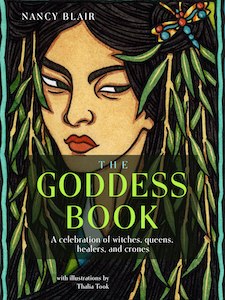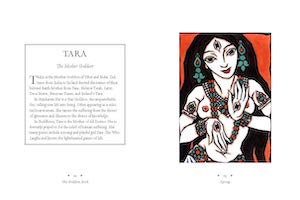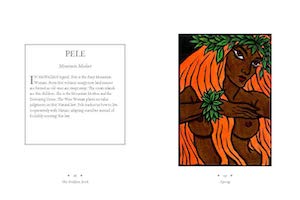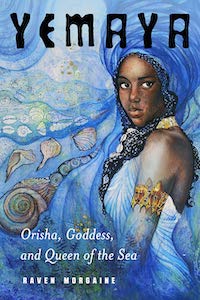
Yemaya: Orisha, Goddess, and Queen of the Sea, by Raven Morgaine
Weiser Books, 1578637430, 208 pages, September 2021
Back in May, sitting atop a small mountain in Joshua Tree National Park and meditating as the sun rose at dawn, the word “Yemaya” came through the silence. Instantly, I felt a sense of peace rush through me. I knew Yemaya was a great ocean goddess, but that was my extent of knowledge about her. When I returned home after this experience, I followed an intuitive nudge to bring some cowry shells down to the ocean and honor Yemaya, thanking her for the beauty of the ocean that I enjoy and the calmness that it brings me.
While I felt a call to continue developing this relationship and explore this quiet prompting from either my intuition or the Universe (not sure!), my summer travels took me away from my home on the California coast and into the canyons of Utah, woods of the Sequoia trees, and cities of the east coast from Philadelphia, PA to Providence, RI. Within my heart though, I kept remembering Yemaya and doing my best to connect with her energy wherever I went.
Now that I’m settled into my daily routine again, back to combing the beaches for seashells and spending my weekends reading on the beach, I felt ready to explore this budding relationship a bit more. However, I will admit I didn’t know exactly where to get started. The Orishas have always felt unreachable for me, a white American woman with European ancestry, due to their African heritage. I am well aware of the training and dedication that goes into becoming a devotee of the Orishas, and I also know how inaccessible these traditions can be to outsiders.
Therefore, you can only imagine my joy in discovering the recently published book Yemaya: Orisha, Goddess, and Queen of the Sea by Raven Morgaine. It was all I’ve been searching for and more!
Morgaine is a spiritual artist who has dedicated his life to Yemaya. He practices Candomble, New Orleans Voodoo, Santeria, and witchcraft. He also owns his own shop, Familiar Spirits, in Coventry, Rhode Island. Most of all, he’s an incredible storyteller that brought all facets of Yemaya to life in this wonderfully written book. His inclusion of practical wisdom, anecdotes, recipes, recipes for making oils and candles, along with plenty of Orisha stories made my connection to Yemaya so much more tangible and alive.
In fact, there were times reading this book when I would put it down and have my thoughts be washed away in feelings of love, tenderness, and security. It felt as though I was coming home to a mother who wanted nothing more than to make me feel loved, nurtured, and supported. While I am only in the beginning phases of building my altar and figuring out what this relationship is going to look like in my life, Yemaya assured me this pathway is open to all and that I will find my way.

Filled with his own written prayers, blessings, and spells, this entire book is imbued with Morgaine’s energy in the best way possible. His love and reverence for Yemaya streams through every word written, from warning those seeking to develop a relationship with Yemaya about what she does not like (never put metal on her altar or use it as a ritual tool, also she’s not a dog person!) to all the ways one can win her favor (beautiful combs, pearls, mirrors, white roses). Morgaine does not cut a single corner in laying out the foundation for establishing a relationship with Yemaya, and he happily delves into stories to illuminate the meaning behind why the practices are done the way they’ve always been done.
I truly loved learning more about many Orishas, from Yemaya’s younger sister Oshun to Shango and Eleggua. Morgaine’s writing was one of the most inviting introductions to the Orishas I’ve ever come across, and for the first time, I felt welcomed to partake in and honor these gods and goddesses.
Though, I will also admit, Morgaine’s solemn warning of what is involved in creating and maintaining a relationship with Yemaya is both awe-inspiring and a bit nerve-wracking all in one. More than anything, he conveys that she is not a goddess to call upon on a whim or to instantly demand quick results from. She is royalty, and thus she wants to be treated with respect, care, and devotion. She enjoys her lavish praise and will actively pursue what she wants, letting the practitioner know what does and does not please her.
The experiences shared by Morgaine of working with Yemaya for over 35 years made me realize just how misconstrued my previous assumptions of this great ocean goddess had been. I particularly enjoyed how he went through all the different facets of Yemaya, naming each one and sharing a bit of background information related to that incarnation of her, so that a more well-rounded picture of her was painted.
Morgaine openly shares trials from his own life, from despair at the end of an abusive relationship to being evicted at a very sensitive time in his life following his brother’s passing, to show readers Yemaya’s ever-present compassion for her children. Likewise, he also recounts times where she graced him with her presences, highlighting that Orisha gods and goddesses are more than just abstract energies; they are dedicated protectors, guardians, and way-showers of the natural world and humanity.
What has me most inspired is the descriptions of how to build an altar. I am looking forward to creating the time and space to do this soon. I knew I had been collecting seashells, sand dollars, and mermaid figurines for something! And thanks to the wisdom Morgaine has imparted in Yemaya, I also plan on creating cleansing and protecting my house as well.
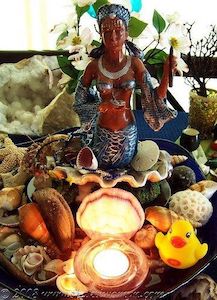
Once again, I must impart how thorough Morgaine is in his details of doing these things. He even describes how it’s good to have an altar with drawers to store sacred objects, where to find affordable old furniture, and how to cleanse the furniture. At other times, Morgaine reminds the reader to use a dust mask or that a certain spell might smell weird, but that’s okay. His conversational writing style makes it feel like I am directly receiving this valuable information from a beloved teacher, mentor, and friend.
Somehow, Morgaine finds the perfect mixture of lightheartedness and seriousness to impart these lessons with care and consideration both of Yemaya and the well-being of the practitioner. He very much wants to ensure Yemaya is honored in a way that is pleasing to her, and he also wants to make sure practitioners don’t make foolish mistakes that can have detrimental impacts. Truthfully, he’s the perfect mediator between both, an ambassador if you will, in establishing this relationship.
And what’s so special about Morgaine’s perspective in Yemaya is that it’s inclusive. For him, having a relationship with Yemaya is not limited by one’s race, gender, sexual orientation, or cultural background. He draws parallels between Mother Mary and Isis with Yemaya, as well as acknowledging that many pagans choose to work with deities outside of their own culture’s pantheon. There’s a lovely section on how different aspects of Yemaya are protectors of people of all gender and sexual orientations — Yemaya is mother to us all.
Oh, I could keep raving about this book forever! All in all, Yemaya is a wonderful book to begin a relationship with the great mother ocean goddess. Morgaine teaches the reader how to cultivate a spiritual practice dedicated to Yemaya through telling her stories with the Orishas, sharing her many aspects of self through reincarnation, what offerings she loves and what things she dislikes, and how to establish a relationship nearby or far from the ocean. The anecdotes, recipes, magical associations, and practical wisdom from Morgaine are enough to get someone started on this path for at least a few years!
Alanna Kali is an astrologer, numerologist, and pioneer spirit that loves to explore life through the lens of depth psychology. She has a passion for studying the humanities and social trends. Her academic work is centered upon reuniting body, mind, and spirit through eco-psychology. She loves reading, spending time in nature, and travel.


